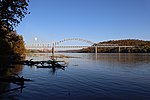Fort Finney (Ohio)
Fort Finney was a fort built in October 1785 at the mouth of the Great Miami River near the modern city of Cincinnati and named for Major Walter Finney who built the fort. The site was chosen to be midway between Falls of the Ohio and Limestone (Maysville), two early settlements on the Ohio River. Earlier, George Washington had commissioned Generals George Rogers Clark, Richard Butler and Samuel Parsons to make a peace treaty with the Shawnee Indians, and a fort was needed to secure the territory. A company under Major Finney was dispatched in fall, 1785 from Fort Pitt to build the fort. The fort was abandoned sometime before the Symmes Purchase in 1788. Today, the site is the coal yard of the Miami Fort Power Station.
Excerpt from the Wikipedia article Fort Finney (Ohio) (License: CC BY-SA 3.0, Authors).Fort Finney (Ohio)
Brower Road, Miami Township
Geographical coordinates (GPS) Address Nearby Places Show on map
Geographical coordinates (GPS)
| Latitude | Longitude |
|---|---|
| N 39.114444444444 ° | E -84.800555555556 ° |
Address
Brower Road 10901
45052 Miami Township
Ohio, United States
Open on Google Maps






